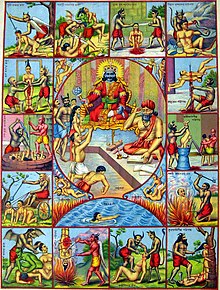Naraka (mythology)
Naraka (Sanskrit: नरक) or Narakaloka is the Sanskrit word for the underworld. The term can be found in all four Indian religions ( Hinduism , Jainism , Buddhism and Sikhism ). Naraka is a place of suffering and physical agony and thus corresponds roughly to the term ' hell '. Naraka and the opposite term svarga do not designate a final state, but only a transitional phase of the soul before it is reborn .
Hinduism
In the Vedas , Upanishads , Puranas and other Hindu texts, Naraka denotes the place where souls go before a new birth for the purpose of the redemption of their sins. The term Naraka is mentioned several times in the Bhagavad Gita . It is a place of darkness and emotional and physical suffering. Some schools of Hinduism understand Naraka as purely metaphorical and reject the actual existence of Hell; others divide hell into several areas or levels. Lord of the underworld is the god of the dead Yama and so the term Yama loka is often used as an equivalent to Naraka ; Yama's assistant Chitragupta writes down all the deeds of living beings in a book and assigns them a place in hell ( naraka ) or in heaven ( svarga ) accordingly . However, some authors are of the opinion that even minor offenses can be punished with a temporary stay in Hell - according to Mahabharata even the heroes of the story, the five Pandava brothers, who otherwise embody sincerity and virtue, spend a certain time in the Underworld. Within Hinduism, the time spent in hell - except for the Hindu philosopher Madhva , who assumes that the guilt of completely unrighteous people is inevitable - is not viewed as an eternal damnation, but as a temporary process.
Yama has other servants, the Yamadutas, who are busy capturing sinful souls and dragging them into the underworld / hell. Only the Vaishnavas are spared and are led by them into paradise ( vaikuntha or goloka ).
Buddhism
In many ways, the Buddhist concepts and understandings of Naraka coincide with the Hindu ones. The main difference is that the Buddhist worldview and thus also the underworld does not know a god who sets punishments and sorts the souls, but only the inexorable law of karma determines their fate. The deepest level of Buddhist hell is called Avici . The Buddhist-influenced concept of hell in Chinese mythology is known as Diyu . The modern Buddhist notions of hell in East and Southeast Asia, however , have been permeated to a certain extent by Christian-Western or also by Islamic ideas ( jehenna ).
Jainism
The Jainist concept of 'hell' does not differ much from the Buddhist concept. The underworld is divided into seven areas ( prabhas ).
Indonesia and Malaysia
The slightly modified term Neraka is used in Indonesia and Malaysia to describe the Islamic concept of 'hell'.
Web links
Individual evidence
- ↑ Helmuth von Glasenapp : Der Hinduismus. Religion and Society in Today's India, Hildesheim 1978, p. 248.

